IMPROVED CLINICAL,ZOOLOGIST & FIELD MICROSCOPEor
PORTABLE CLINICAL AND FIELD MICROSCOPE
| DESCRIPTION | HISTORY | W.F.STANLEY |
Please Click On Any Picture for a Larger Version
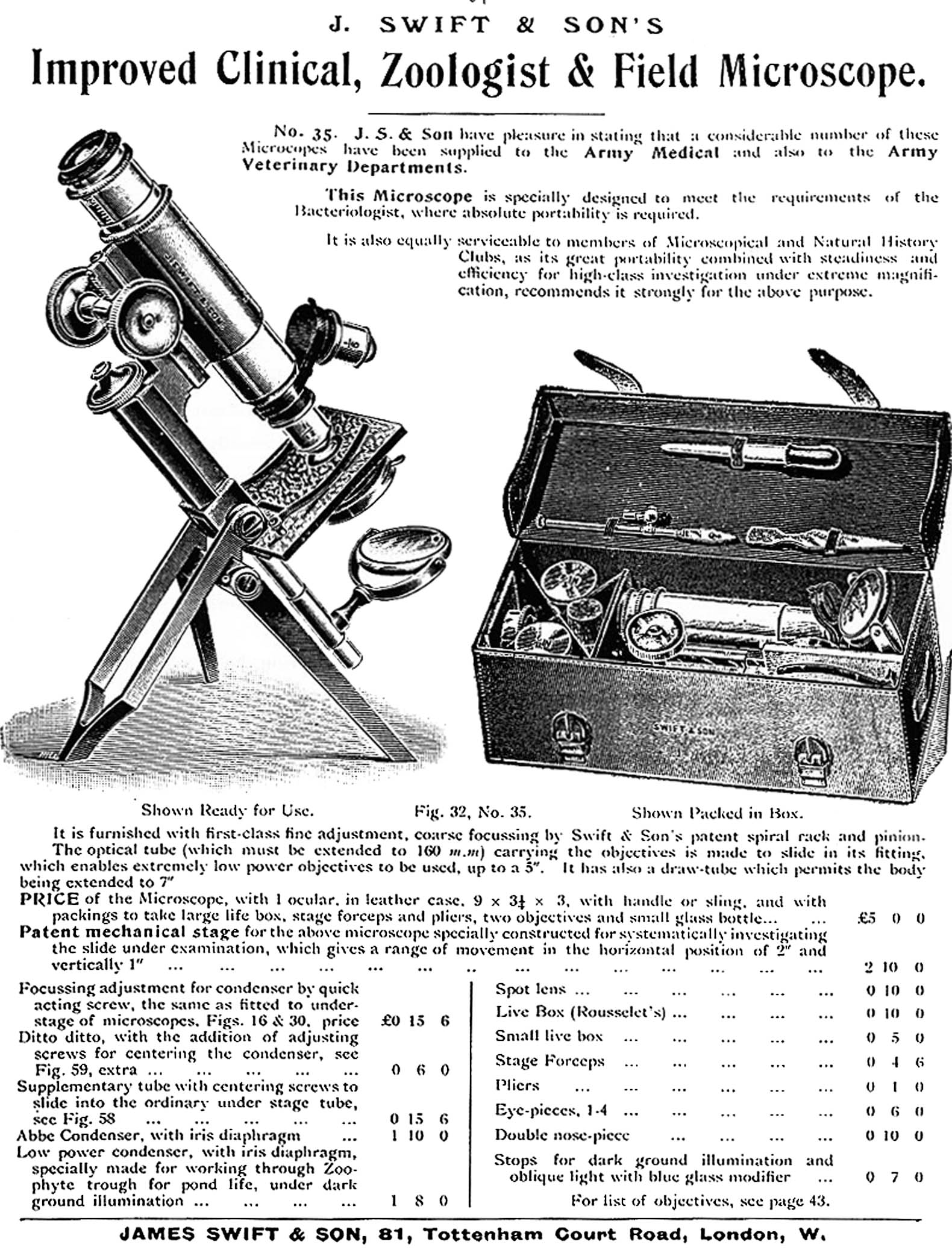 DESCRIPTION: The instrument, offered for about a quarter century starting in 1900, arises from a modified folding tripod foot. The rear leg is split such that when folded it passes around the fine focus, thus allowing a more compact arrangement. The two front feet are attached to the rear foot, folding forward when in use. All three feet have tight joints and firm stops in the setup position, allowing a very sturdy stand. The lacquered brass sleeve carrying the optical tube is signed 'J. Swift & Son, London, No 116' The main optical tube is nickel plated and slides through the lacquered brass sleeve which has coarse focus by spiral rack and pinion and fine focus by micrometer screw. There are stops in both the up and down extremes to prevent the main focusing sleeve from coming off the limb. There are multiple screws to allow adjustment of the focusing mechanism for wear. A hole in the limb is provided to accept an accesory such as a stage forceps or reflector(not present). A removeable double nose piece is present. The nickel-plated draw-tube is also nickel plated and finely calibrated from 13 to 21 cm, labeled each cm and marked each mm. The stage is hinged to the frame of the microscope by a sturdy tight joint. The stage clips and all screws are blued steel. The stage is 3 inches x 3 inches and has slots on the sides which could accomodate a small version of the Swift Travis mechanical roller stage, (not present) The plane and concave double sided gimbaled mirror slides up and down a tail piece. There is also a Abbe type condenser signed 'F. STANLEY & Co Ltd, OPTICIANS, 13 Railway Approach, London Bridge S.E.'. The condenser slides into the standard substage sleeve and is equipped with an iris diaphragm. Accesories include a hard leather case, 1/2 inch and 4/10 inch objectives with cans, both by Swift. The 4/10 has a correction collar. There are three eyepieces: a low power, medium power, and high power. The medium power one has a pointer. The low power ocular is nickel plated and signed 'A', the other two are plane brass.
DESCRIPTION: The instrument, offered for about a quarter century starting in 1900, arises from a modified folding tripod foot. The rear leg is split such that when folded it passes around the fine focus, thus allowing a more compact arrangement. The two front feet are attached to the rear foot, folding forward when in use. All three feet have tight joints and firm stops in the setup position, allowing a very sturdy stand. The lacquered brass sleeve carrying the optical tube is signed 'J. Swift & Son, London, No 116' The main optical tube is nickel plated and slides through the lacquered brass sleeve which has coarse focus by spiral rack and pinion and fine focus by micrometer screw. There are stops in both the up and down extremes to prevent the main focusing sleeve from coming off the limb. There are multiple screws to allow adjustment of the focusing mechanism for wear. A hole in the limb is provided to accept an accesory such as a stage forceps or reflector(not present). A removeable double nose piece is present. The nickel-plated draw-tube is also nickel plated and finely calibrated from 13 to 21 cm, labeled each cm and marked each mm. The stage is hinged to the frame of the microscope by a sturdy tight joint. The stage clips and all screws are blued steel. The stage is 3 inches x 3 inches and has slots on the sides which could accomodate a small version of the Swift Travis mechanical roller stage, (not present) The plane and concave double sided gimbaled mirror slides up and down a tail piece. There is also a Abbe type condenser signed 'F. STANLEY & Co Ltd, OPTICIANS, 13 Railway Approach, London Bridge S.E.'. The condenser slides into the standard substage sleeve and is equipped with an iris diaphragm. Accesories include a hard leather case, 1/2 inch and 4/10 inch objectives with cans, both by Swift. The 4/10 has a correction collar. There are three eyepieces: a low power, medium power, and high power. The medium power one has a pointer. The low power ocular is nickel plated and signed 'A', the other two are plane brass. 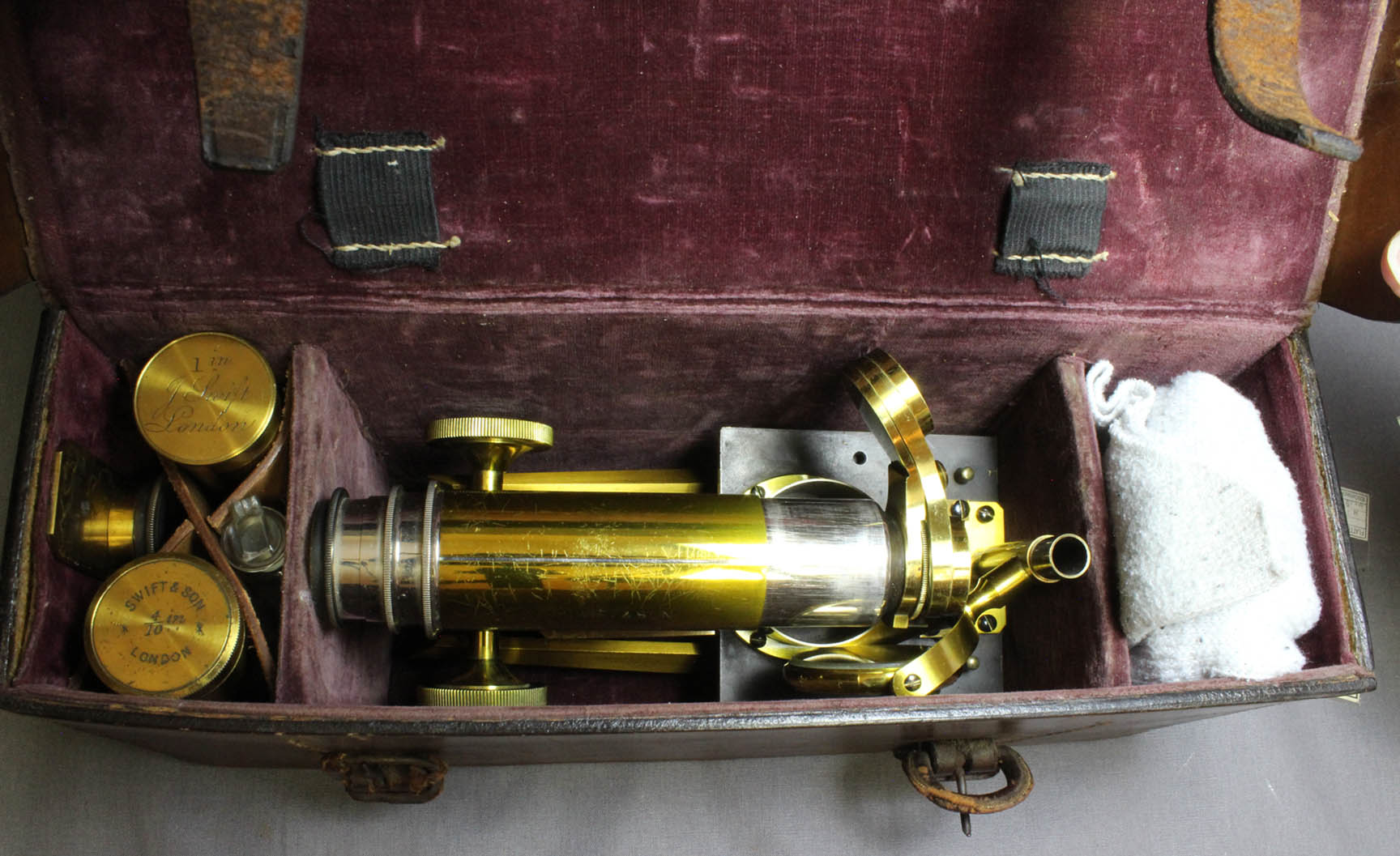 The case is designed to hold two objective cans, a live box, a bottle, extra oculars and the condenser. The inside lid has elastic straps to hold a stage forceps, dropper and tweezer though these are lacking. This example has an unusually large case with compartments on either side of the microscope for accessories; compare to the 1906 catalog illustration where the box has room for accessories only on one side. The condenser and extra eyepieces are wrapped in cloth in the compartment on the right side.
The case is designed to hold two objective cans, a live box, a bottle, extra oculars and the condenser. The inside lid has elastic straps to hold a stage forceps, dropper and tweezer though these are lacking. This example has an unusually large case with compartments on either side of the microscope for accessories; compare to the 1906 catalog illustration where the box has room for accessories only on one side. The condenser and extra eyepieces are wrapped in cloth in the compartment on the right side.
spiralor
diagonalrack and pinion coarse focus were groundbreaking.
 Apparently Swift's first
Apparently Swift's first folding portable microscopewas
Blankley's Folding Portable Microscopeas shown in the c. 1873 Swift Catalog. It appears to be a somewhat flimsy design, and was apparently offered for only a short period of time. This should not be confused with the more commonly seen Blankley Pocket Microscope, also by Swift.
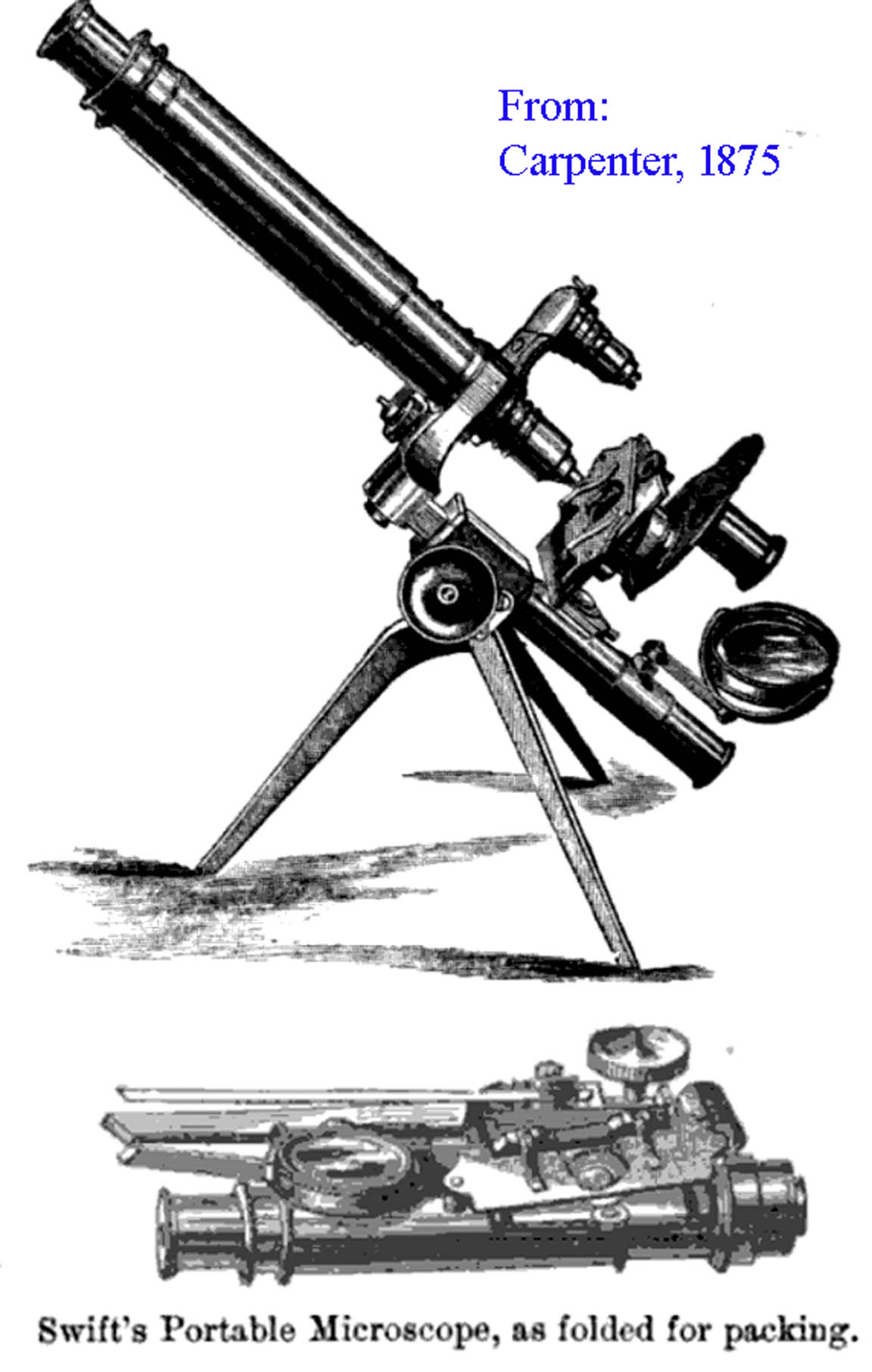
New Portable Compound Microscope. It features bar-limb construction with a swiveling joint at the top of the bar to the arm and also a swiveling stage, both to facilitate its folding into a compact form for traveling. This microscope was likely inspired by the Powell & Lealand No 4 which was a fine and complete instrument, but very expensive. Swift's answer to the P & L No 4 is shown to the left set up for use and folded for travel. This microscope had many desirable features, such as substage condenser and fine focus, but was not as sophisticated as the P & L No 4. This model was offered for many years.
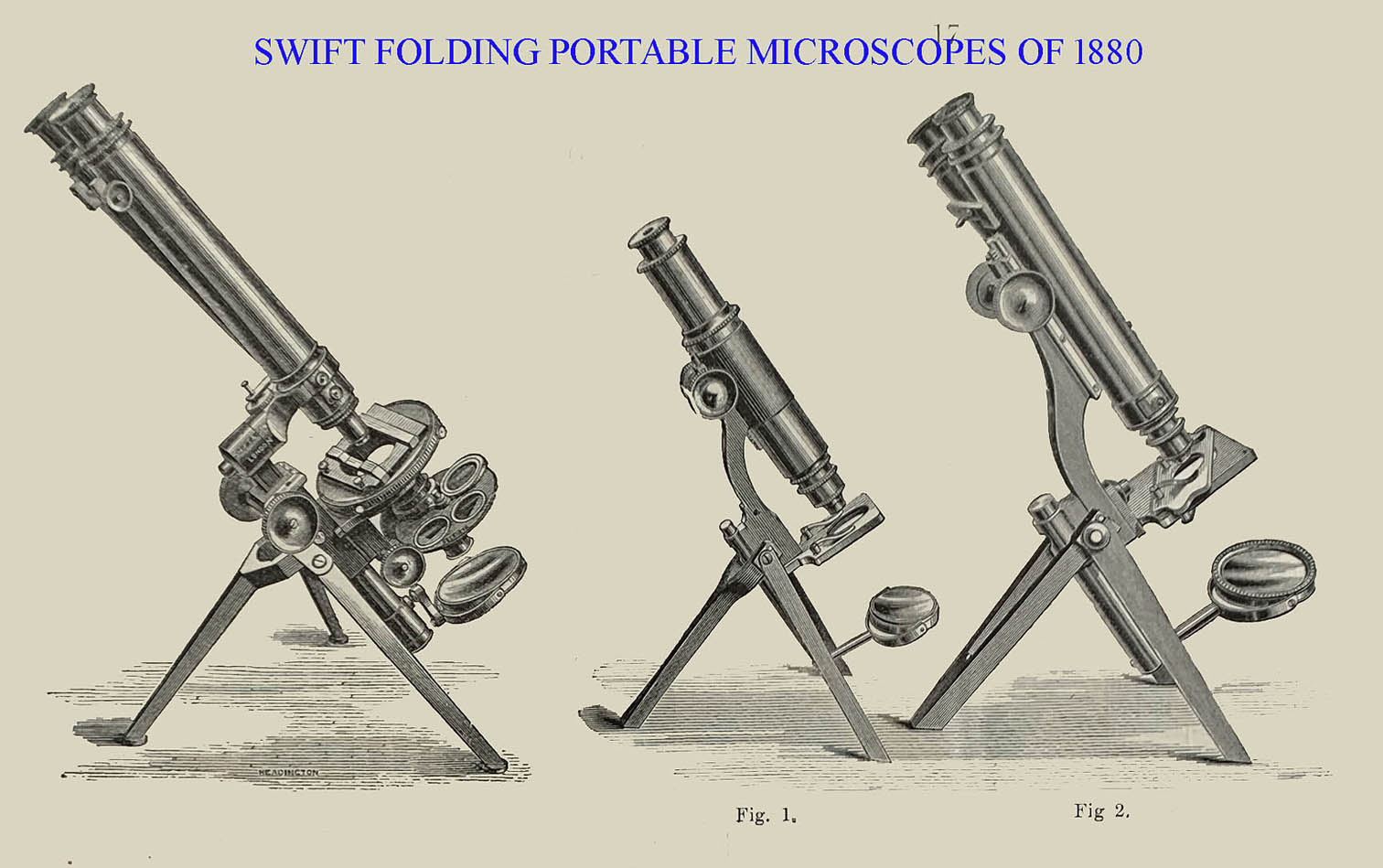
New Portable Compound Microscopewas still being offered in 1880, Swift introduced two other simpler folding portables with Lister limbs in that year. These were the
Small Portable Simple Microscopeand the
New Simple Portable Folding binocularThe Simple Folding Portable Binocular was still offered in 1910, but apparently not after that. The
New Portable Compound Microscopestill offered in 1892, was no longer offered in the 1906 catalog, apparently replaced by the
NEW PORTABLE CLINICAL MICROSCOPE(see below) .
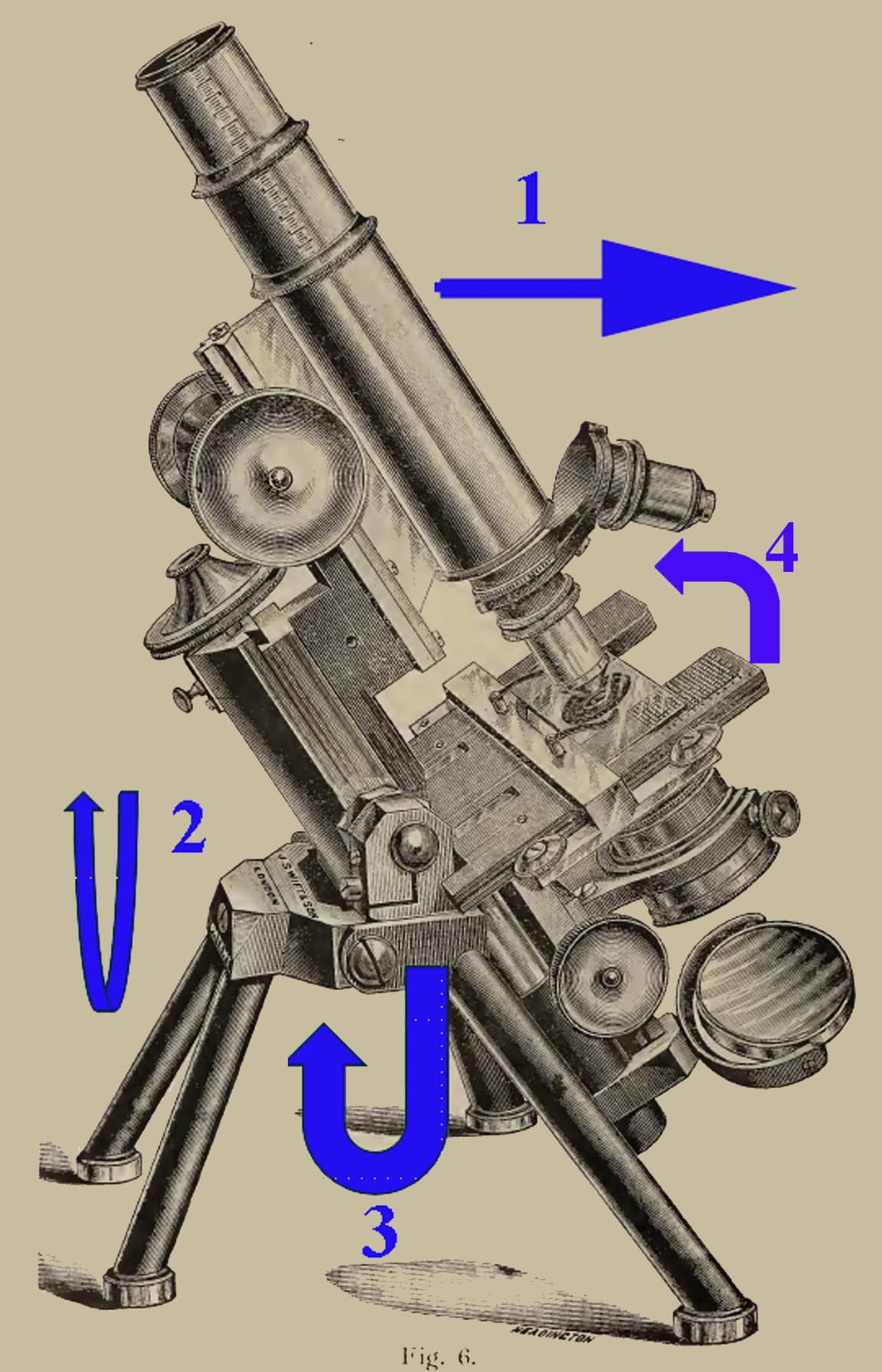
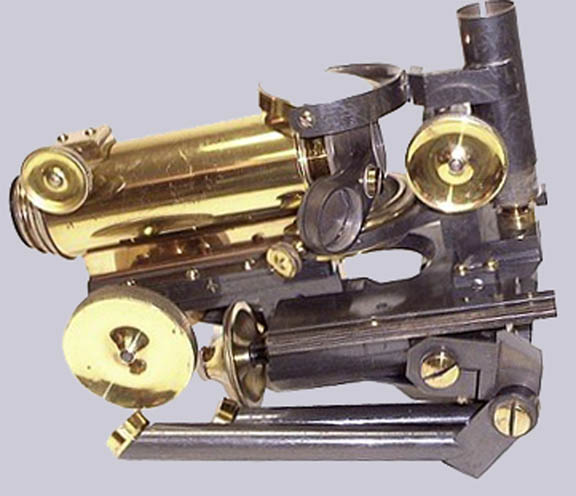
New Histological and PhysiologicalModel. This microscope had four legs, but the back two were attached to a right-left swiveling piece which assured the microscope would sit firmly even if the surface of the table was not flat. Shortly thereafer Swift produced a Portable form of this where the swivel persisted and could be used to swivel the legs to an upward position, and the forward two legs folded backward on top of the the upward rear legs. The stage then folded upward, the entire package being quite compact. It was still offered in the 1906 Swift catalog as the
Portable Histological and Physiological Microscope. This model was no longer listed in the 1913 Swift catalog.
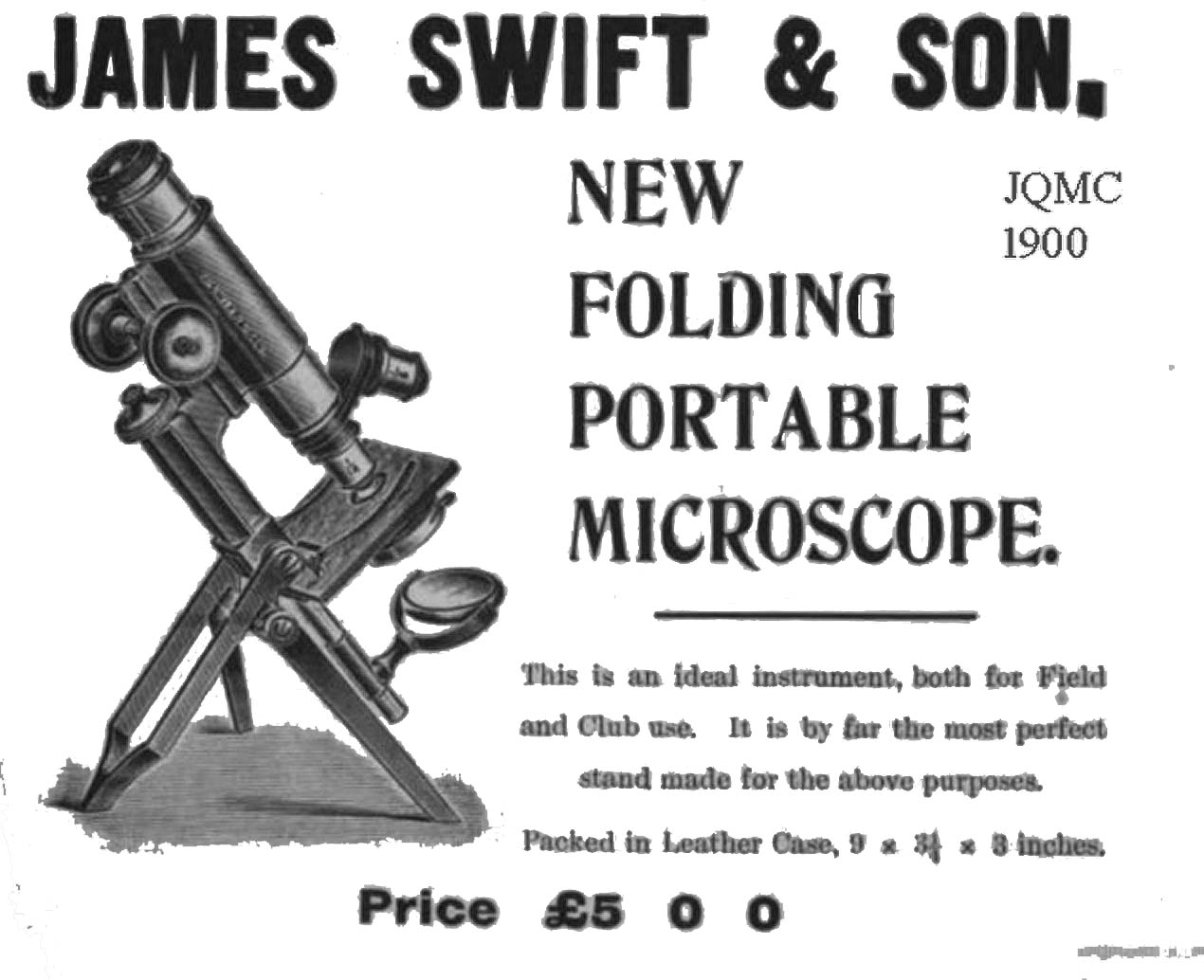
Improved Clinical, Zoologist, & Field Microscopewas first advertised in 1900.

IMPROVED CLINICAL,ZOOLOGIST & FIELD MICROSCOPEfeatured on this page offered but a new model called the
NEW PORTABLE CLINICAL MICROSCOPEwas now offered.
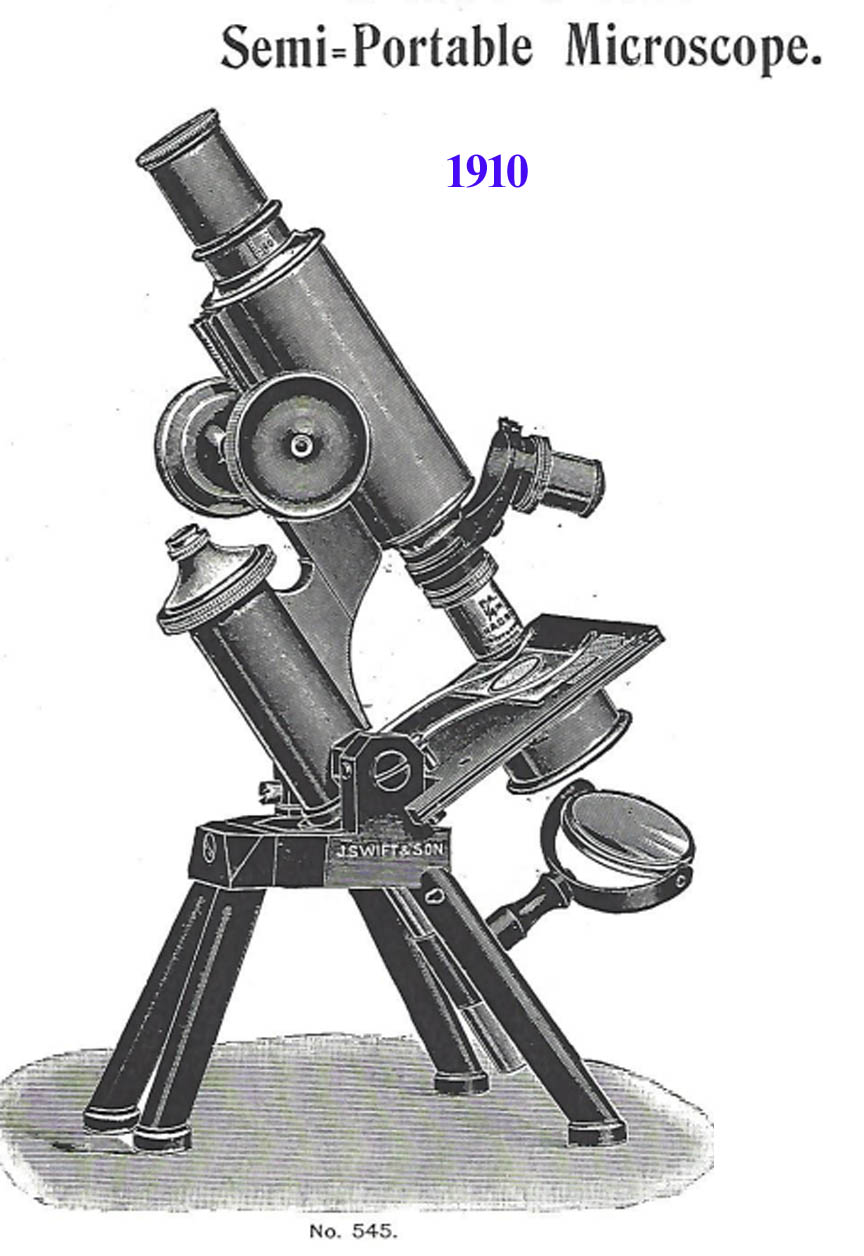
Semi-Portablewith a substage ring for accessories had the swiveling pair of rear legs which could swing up to allow this microscope to be partially folded.
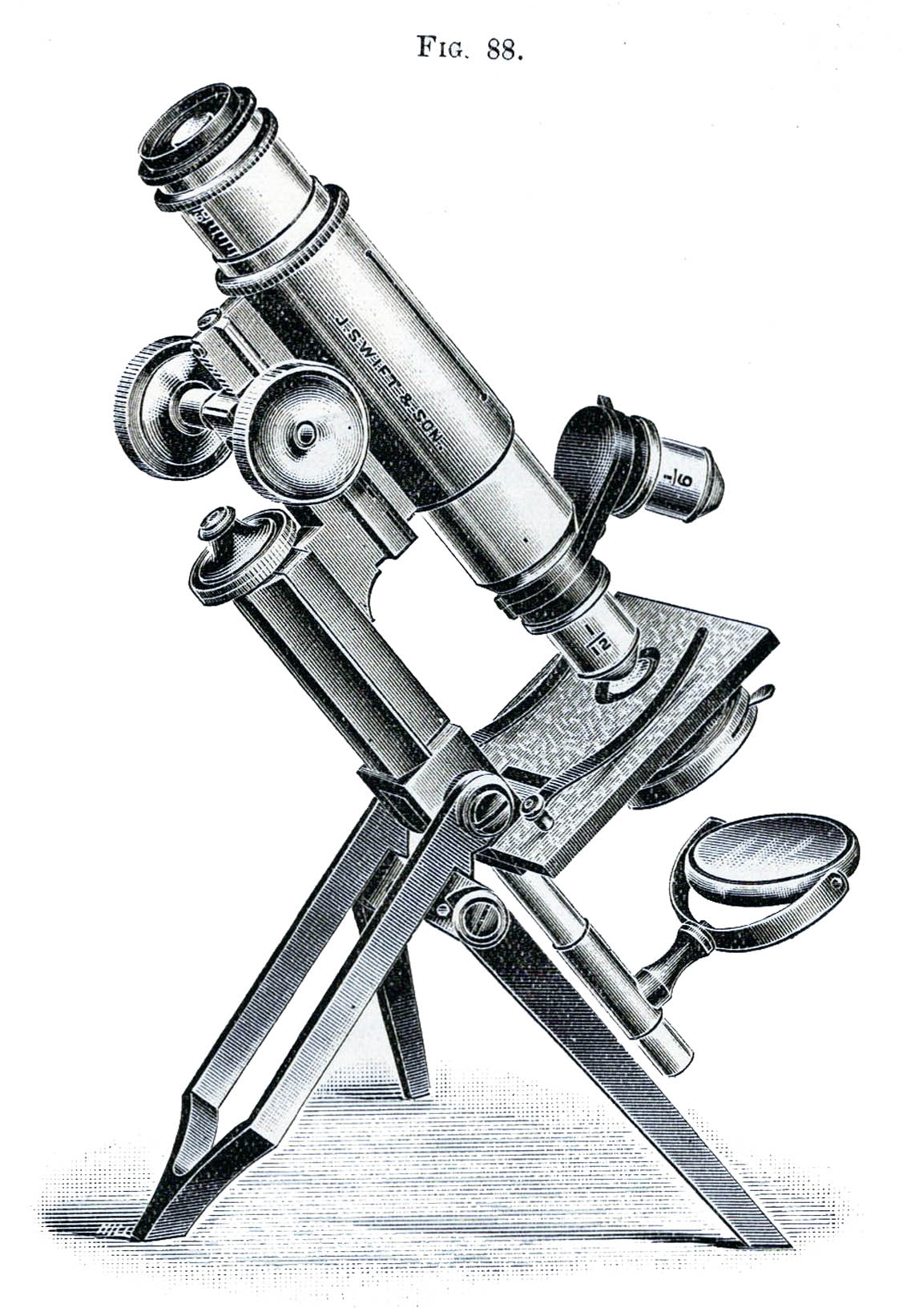 Swift and Son designed the folding portable microscope shown at the top of this page, with its rugged leather case, for military doctors and traveling scientists, possibly under the influence of Charles Baker's "The Diagnostic No. 1". It was reported on page 379 and pictured on page 381 of the JRMS for the year 1900. In that article it was simply referred to as 'Swift's New Portable Microscope". As the sales advertisement by J. Swift & Son, ca. 1900, states: “This microscope was originally designed to meet the requirements of the Bacteriologist who needed an instrument of utmost portability. It is particularly serviceable to Microscopical and Natural History Societies, as its extreme portability, combined with great steadiness and efficiency for high power investigations, recommends it strongly. These instruments are in very general use in India and Africa amongst those working on Malaria, Sleeping Sickness, etc., and have been supplied in great numbers to the Army Veterinary Departments, the Crown Agents for the Colonies, the United States Government, etc.” In his review of lightweight portable microscopes, Scales, in his 1909 book Elementary Microscopy, A Handbook for Beginners stated:
Swift and Son designed the folding portable microscope shown at the top of this page, with its rugged leather case, for military doctors and traveling scientists, possibly under the influence of Charles Baker's "The Diagnostic No. 1". It was reported on page 379 and pictured on page 381 of the JRMS for the year 1900. In that article it was simply referred to as 'Swift's New Portable Microscope". As the sales advertisement by J. Swift & Son, ca. 1900, states: “This microscope was originally designed to meet the requirements of the Bacteriologist who needed an instrument of utmost portability. It is particularly serviceable to Microscopical and Natural History Societies, as its extreme portability, combined with great steadiness and efficiency for high power investigations, recommends it strongly. These instruments are in very general use in India and Africa amongst those working on Malaria, Sleeping Sickness, etc., and have been supplied in great numbers to the Army Veterinary Departments, the Crown Agents for the Colonies, the United States Government, etc.” In his review of lightweight portable microscopes, Scales, in his 1909 book Elementary Microscopy, A Handbook for Beginners stated: 'But perhaps the best portable microscope yet designed to combine perfect efficiency with complete portability and moderate price is that of Swift and Son. It is beautifully finished in brass, and is suitable for travelling, for clinical and for field work, or for home use. It is furnished with both coarse and fine adjustments, the latter being markedly superior to those usually fitting to microscopes of this type. The optical tube slides in its fitting so as to allow very low-power objectives to be used, whilst the draw tube permits of an extension to 7 inches. The stage is larger than usual, and contains a substage ring fitted with Abbe condenser of full size and iris diaphragm. The back leg is divided so as to pass over the fine adjustment screw when folded, whilst the stage is hinged, and lies flat against the body of the microscope. The whole packs into a leather case 9 x 3 x 3 inches, with space for two objectives, live box, small bottle, and sundry minor apparatus...and costs without objectives or other apparatus, £5.'
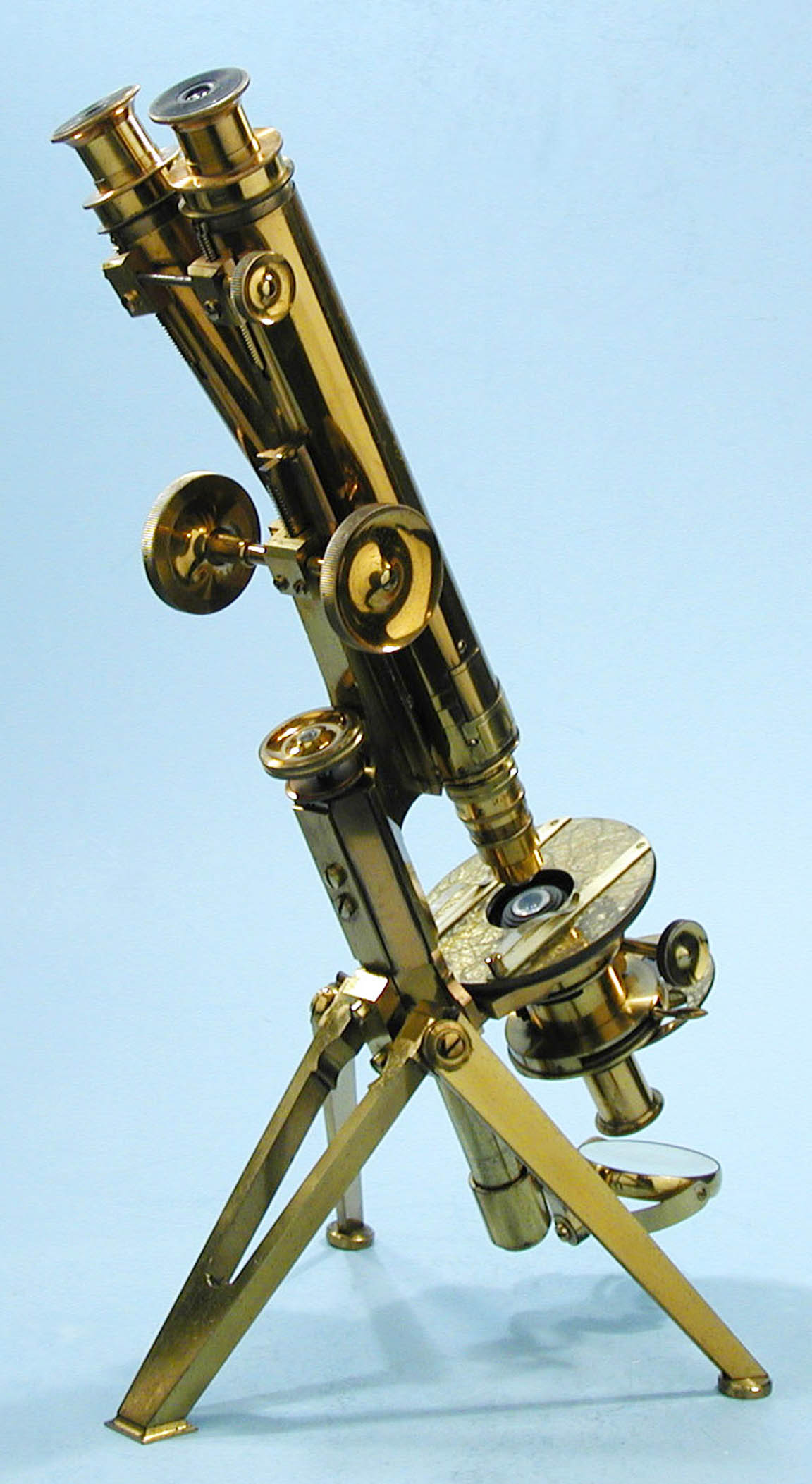 At least 8 different folding portable microscopes by Swift are documented but just as with other makers, transitional models, which are not neccesarily well documented, do exist and this is one example. While it has a round stage, as did the folding portables from 1890, it has a Continental Style Limb similar to the Improved Clinical Zoolobist and Field model shown at the top of the page, produced from 1900 until well into the 20th century. The rear leg is not the same as that microscope, nor like the earlier folding models except the
At least 8 different folding portable microscopes by Swift are documented but just as with other makers, transitional models, which are not neccesarily well documented, do exist and this is one example. While it has a round stage, as did the folding portables from 1890, it has a Continental Style Limb similar to the Improved Clinical Zoolobist and Field model shown at the top of the page, produced from 1900 until well into the 20th century. The rear leg is not the same as that microscope, nor like the earlier folding models except the New Simple Portable Folding Binocularof 1880 through at least 1894. Although a binocular tube was an option since the original Folding model of about 1874, this microscope has a binocular tube with both a Wenham prism and a separate in-tube analyzer, a feature first noted in the 1880 Swift catalog but with the same older swiveling bar limb design. This microscope then seems to be a form transitional between 1894 and 1900, but to my knowledge not pictured in any Swift catalog, with features introduced in 1880 and 1894, but not quite the same as the 1900 Model featured at the top of this page. Note the microscope accepts the second form of Hall condenser, called by swift the
Popular Achromatic and Tintedcondenser, which has an integrated rack and pinion focus and installs into the ring on the bottom of the stage. This condenser originated about 1870 and was offered until about 1910.
IMPROVED CLINICAL ZOOLOGIST, AND FIELDMICROSCOPE:
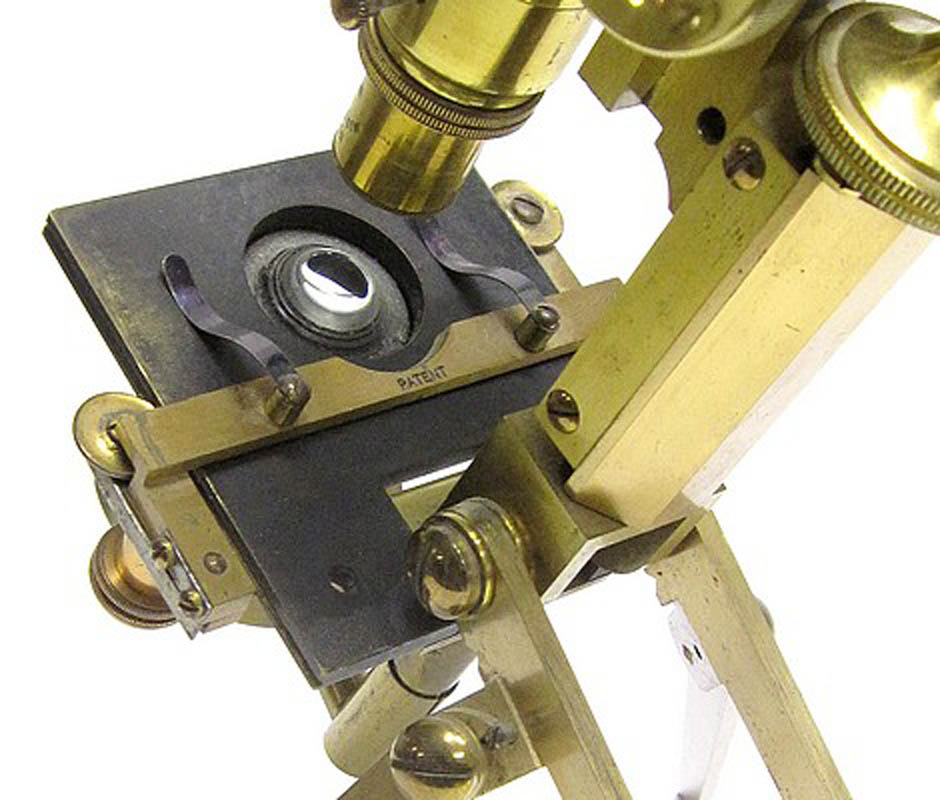 Apparently first offered in 1900, it continued to be offered in the 1906, 1910, and 1913 catalogs by Swift. It was also featured during the Third Optical Convention of 1926* as
Apparently first offered in 1900, it continued to be offered in the 1906, 1910, and 1913 catalogs by Swift. It was also featured during the Third Optical Convention of 1926* as a good example ...of a
small portable stand of value to naturalists and petrologists. It was not offered in the Swift catalog of 1892. This microscope was available with monocular tube or binocular tube. Standard stage clips were supplied but the stage is grooved on its sides to accept either the simple wheeled roller glide stage(see example to left), or the Traviss Mechanical Roller stage. These were special order stage accesories, as they are smaller than the ones for the full size Swift microscopes. Another option offered was a focusing mechanism for the substage sleeve(by vertical wormscrew), with the further option of adjustments for centering. Equipped with a suitable condenser and all these options, it could certainly do almost anything a large full sized microscope could do at the time.
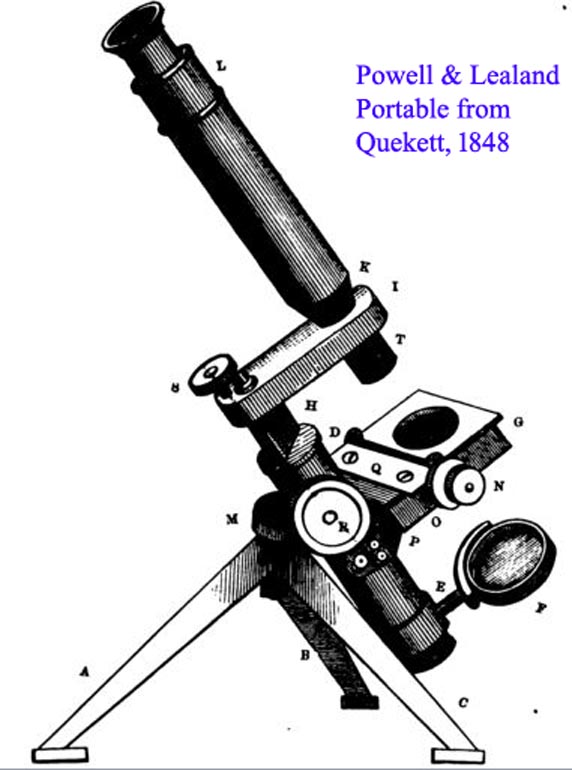
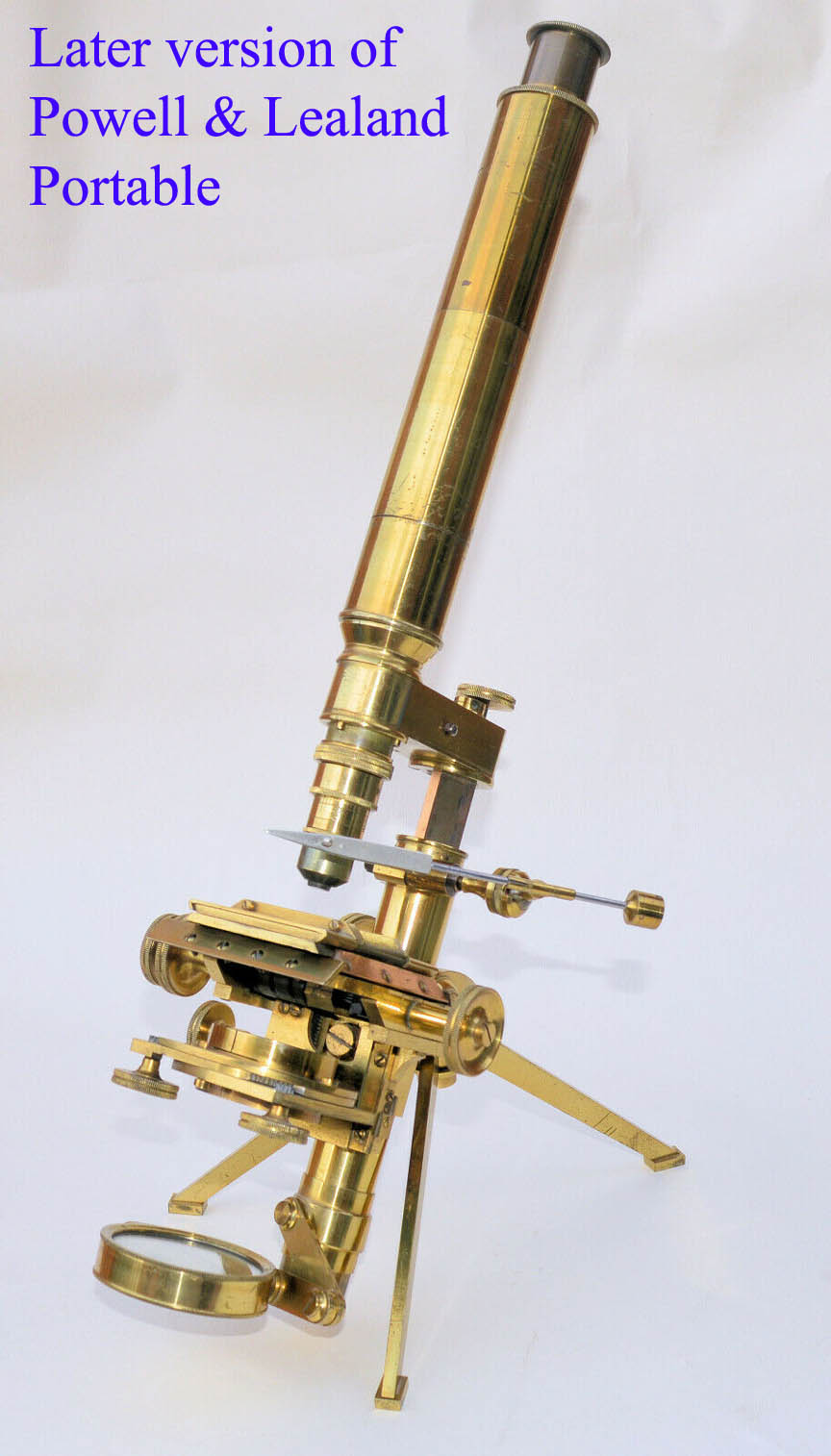 One of the earliest practical folding achromatic portable microscopes, suitable for serious work, was first constructed by Powell & Lealand. P & L's Portable, later called the No.4, was one of the earliest of this type and was shown in John Quekket's book as early as 1848(left). Although the basic design remained unchanged, the most important addition in later versions was the focusable and centerable substage as can be seen in this example on this website(right). One disadvantage of this model was the need to unscrew the main optical tube for folding and packing it up.
One of the earliest practical folding achromatic portable microscopes, suitable for serious work, was first constructed by Powell & Lealand. P & L's Portable, later called the No.4, was one of the earliest of this type and was shown in John Quekket's book as early as 1848(left). Although the basic design remained unchanged, the most important addition in later versions was the focusable and centerable substage as can be seen in this example on this website(right). One disadvantage of this model was the need to unscrew the main optical tube for folding and packing it up.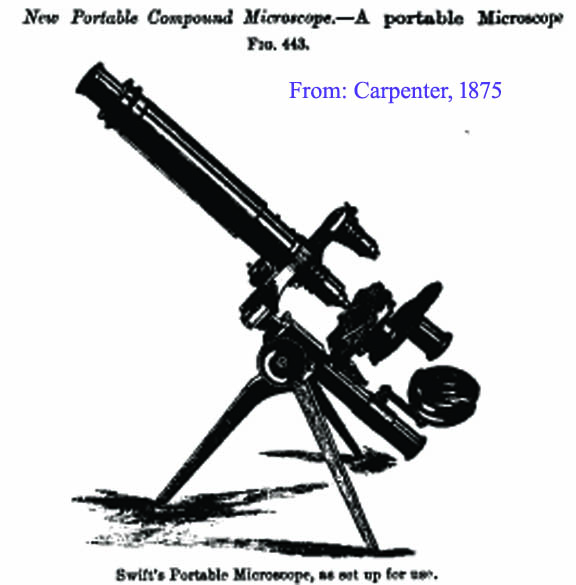 As time went on, and especially from about 1875, all the major manufacturers, including Swift(left) came up with their own versions of 'portable' microscopes, many were bigger and stouter than pocket microscopes but often much lighter than the full size stands, and able to fold up into a much smaller case than a full sized microscope. Although the P & L No.4 was fully capable of almost any work, the portables of other manufacturers were often not as rugged or complete, but the cost of the P & L portable put it out of reach of most. Some 'portable' microscopes with more advanced features would fold up but were heavy and relatively large once assembled.
As time went on, and especially from about 1875, all the major manufacturers, including Swift(left) came up with their own versions of 'portable' microscopes, many were bigger and stouter than pocket microscopes but often much lighter than the full size stands, and able to fold up into a much smaller case than a full sized microscope. Although the P & L No.4 was fully capable of almost any work, the portables of other manufacturers were often not as rugged or complete, but the cost of the P & L portable put it out of reach of most. Some 'portable' microscopes with more advanced features would fold up but were heavy and relatively large once assembled. 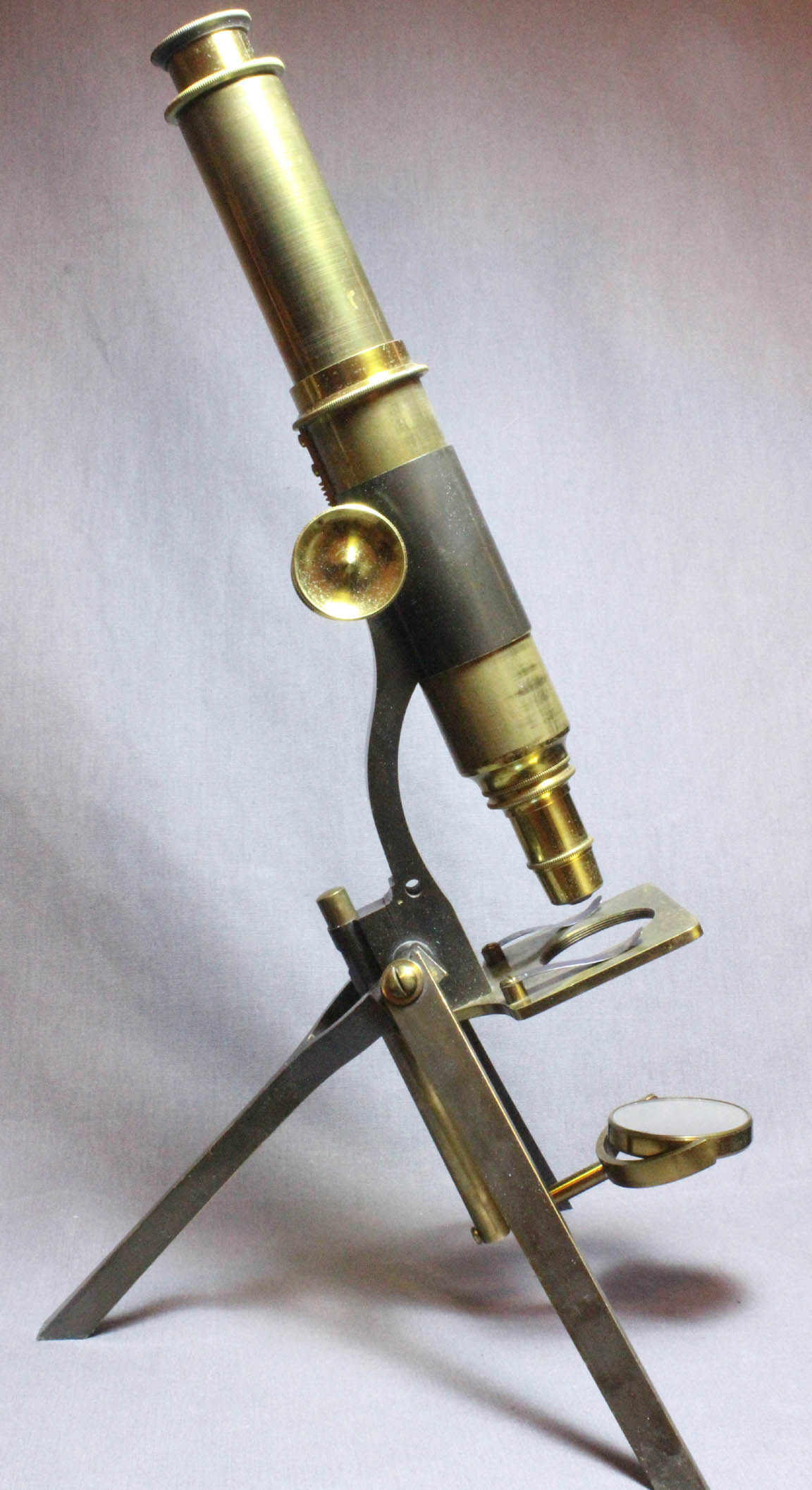
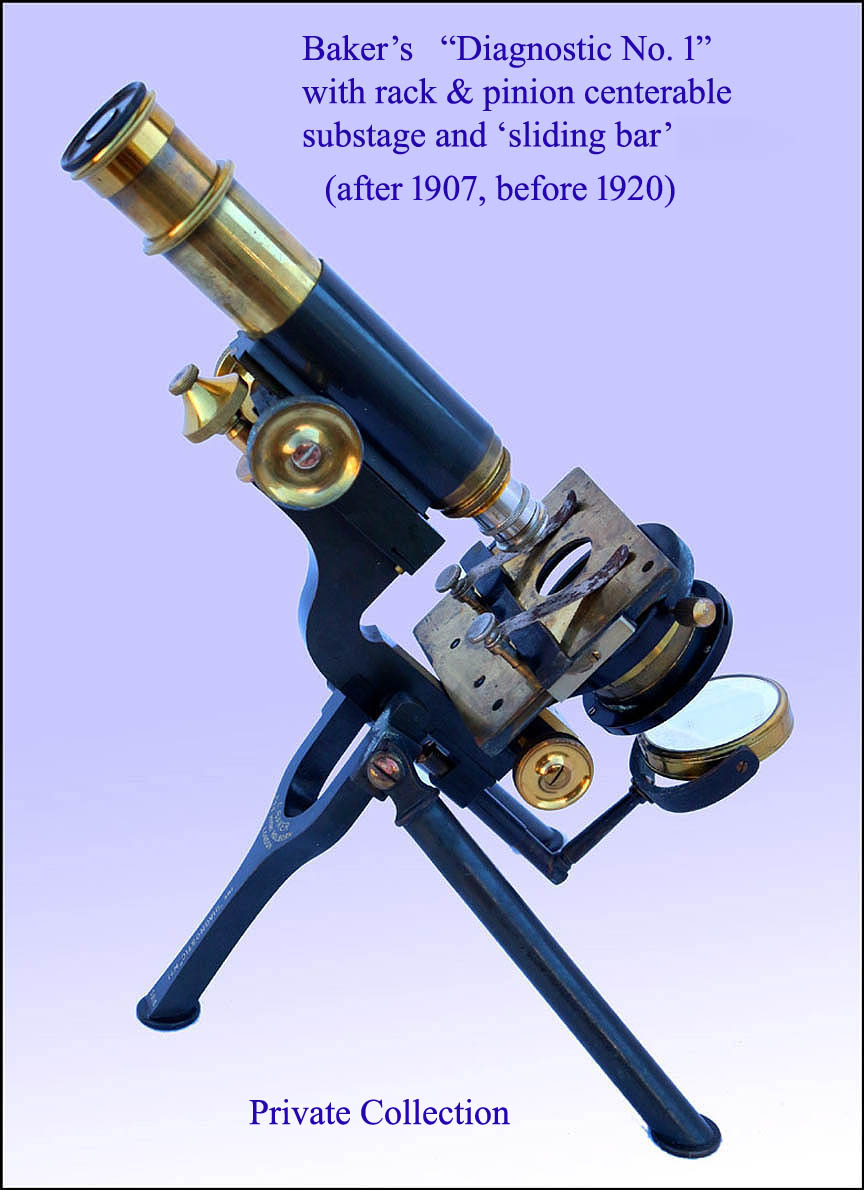 Starting about 1890, most makers produced lightweight microscopes of good quality, but often without standard features like a condenser, and very few with mechanical stages, so high power critical work was not feasible unless special extra accessories were adapted. Judging from examples on the market today, most of these were never adapted for high power work and were used mainly for low power microscopy. As time went on and more serious use of highly portable instruments became a common need, the instruments evolved. An example of this evolution can be seen in the history of the Baker 'New Portable Compound Microscope(left)' as it became the 'Diagnostic' model(right). It began in 1887 as a compact folding microscope with a solid stage and good balance, but without provisions for the features that would allow it to be used to good effect with e.g.oil immersion objectives. As illustrated by the example on the right, it gradually evolved over the next 50 years or more into a first class instrument capable of anything its big brothers could do.
Starting about 1890, most makers produced lightweight microscopes of good quality, but often without standard features like a condenser, and very few with mechanical stages, so high power critical work was not feasible unless special extra accessories were adapted. Judging from examples on the market today, most of these were never adapted for high power work and were used mainly for low power microscopy. As time went on and more serious use of highly portable instruments became a common need, the instruments evolved. An example of this evolution can be seen in the history of the Baker 'New Portable Compound Microscope(left)' as it became the 'Diagnostic' model(right). It began in 1887 as a compact folding microscope with a solid stage and good balance, but without provisions for the features that would allow it to be used to good effect with e.g.oil immersion objectives. As illustrated by the example on the right, it gradually evolved over the next 50 years or more into a first class instrument capable of anything its big brothers could do. | YEAR & CATALOG EDITION | Blankley's Portable | New Portable Compound | Small Portable Simple | New Simple Portable Folding Binocular | Portable Histological & Physiological | 4 legged Semi-Portable | Improved Clinical, Zoologist, & Field Microscope | New Portable Clinical Microscope |
|---|---|---|---|---|---|---|---|---|
| c.1873 ? |
✓ | |||||||
| c.1874 6th |
NIC | ✓ | ||||||
| 1876 7th | ✓ | |||||||
| 1880 11th | ✓ | ✓ | ✓ | |||||
| 1892 19th |
✓ | ✓ | ✓ | |||||
| 1894 | ✓ | ? | ✓ | ✓ | ||||
| 1900 | ? | ? | ? | ✓ | ✓ | |||
| 1906 22nd |
NIC | NIC | NIC | ✓ | ✓ | ✓ | ||
| 1910 23rd |
✓ | ✓ | ✓ | NIC | ||||
| c. 1913 26th |
NIC | NIC | ✓ |